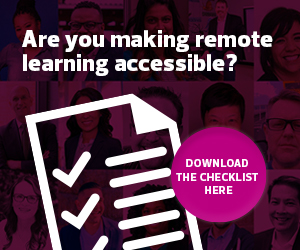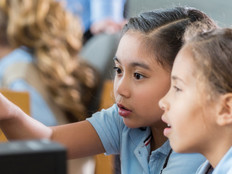How District Offices Can Lead This Work
One way that districts can support educators as they create inclusive classrooms is to evaluate the technology platforms they use. This work is not just for technology departments to manage alone; it is essential for curriculum and instruction departments to partner with technical staff. Conduct accessibility checks to ensure platforms and resources used for remote learning are safe for students and integrate with pre-existing systems. Turn on captions as a default for instructional videos. Ensure software or platforms have a text-to-speech option. Be mindful of those and other features that can help students understand and engage with lessons.
It’s also important to be strategic about instruction. Many schools have adjusted the amount of instructional time to include synchronous and asynchronous instruction. Because of this, districts should work with curriculum teams to prioritize what students need to learn to ensure they can successfully advance to subsequent grades. Include educational technology and special education experts in these conversations. These professionals understand what resources are available and what supports the district can put in place for students and teachers. Providing educators with additional direction on what content standards to address, and what supports are already available, can enable teachers to focus not just on what to teach but also on how to teach online.
Watch Marialice Curran, founder of the Digital Citizenship Institute, talk about how to make digital content more accessible for students.
For students with severe disabilities, many schools struggle with providing services during remote learning. Staffing shortages and limitations on meeting face to face exacerbate those challenges. As districts move into the new school year, they must address what services they can provide remotely, what support they will provide parents, and how individualized education programs (IEPs) may be modified to address learning from home. Can physical and speech therapists’ work be moved online? Can teachers provide parents with ways to support life skills lessons? When looking ahead to hybrid instruction, is it feasible to prioritize bringing these classes back on campus? It is essential to reach out to your local and state education agencies as they continue to release guidance on how to address these students’ needs.
Develop Connections to Boost Student Inclusion
It starts with relationships. Teachers can create a space in which students feel connected to instruction through their teaching practices, interactions and lessons in their pedagogy. We know that when students feel that they are cared about, and when they feel a connection with instruction, they are more likely to engage. In inclusive classrooms, that involves ensuring students with IEPs can access the curriculum as their peers would.
Things teachers would do in traditional classrooms to build community rely on face-to-face interactions. When reviewing student work, they can walk around, look over students’ shoulders, and read their expressions or body language. That’s more difficult in a remote environment. Instead, for example, they could spend the first few days of remote instruction focusing on norms and digital citizenship as well as demonstrating for students how to navigate the digital platform. Just as they would in a standard classroom, they could differentiate instruction, teaching concepts in different ways that students might better absorb. While differentiating instruction, make sure students know they can interact with you as well as each other. Ensure the educator who specifically works with students with disabilities checks in to observe the class, demonstrating not only support for the teacher but the students as well.
Educators should also check in with families and make parents aware, as much as possible, of what is happening with their students.
DISCOVER: Find out how Microsoft Teams supports inclusive remote learning.
Accommodating Disabilities Supports Learning for All
Implementing Universal Design for Learning, or better understanding how humans learn, is another great place to start. UDL focuses on neuroscience and the neurological networks that impact learning. The UDL framework can offer guidelines and guideposts to consider when crafting lessons and activities for students.
Keep in mind that many students might not understand why they’re struggling. And UDL, whether implemented in person or in a remote environment, enables educators to boost inclusion.
These efforts benefit all students — something I can attest to from personal experience. As a student, I was identified as gifted and talented. I compensated for learning disabilities that I had but didn’t know about until I was diagnosed later in life. I remember struggling with some lessons or concepts without fully understanding why. At times, I felt confused and frustrated about my own education. I’m not saying UDL would have solved everything for me, but I believe it would have had a positive impact.
By shifting the district lens to thinking about special education first, leadership and educators can ensure practices and procedures include the needs of all students from the start. Doing this will support educators as they create inclusive spaces, differentiate instruction, and implement inclusive practices that support progress toward meeting the needs of special education student and their peers.
This article is part of the “ConnectIT: Bridging the Gap Between Education and Technology” series. Please join the discussion on Twitter by using the #ConnectIT hashtag.







![[title]Connect IT: Bridging the Gap Between Education and Technology [title]Connect IT: Bridging the Gap Between Education and Technology](http://www.edtechmagazine.com/k12/sites/default/files/articles/2014/05/connectit.jpg)




